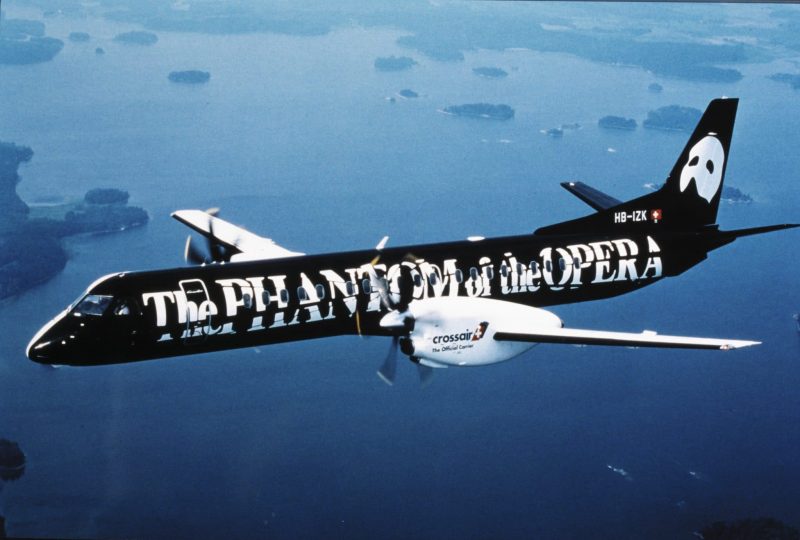The print advertisement shown below caught our eye a few days ago. But why is Saab still promoting its Saab 20 over 2000 years after the end of production? Aviation.direct would like to find an answer to this.

After the great success of the Saab 340, the Swedish aircraft construction and armaments company Saab AB (then still called Saab-Scania AB) set out in December 1988 to develop an enlarged regional aircraft - the Saab 2000. But the Saab 2000 is not just one stretched Saab 340, but a completely redesigned aircraft.
The final assembly in Linköping relied on various innovations and above all on powerful turboprop engines from the Allison Engine Company (now part of Rolls-Royce). The two AE2100A engines give the Saab 2000 enormous thrust, so that the cruising speed of 665 km / h was about 100 km / h higher than that of the direct competing models (ATR42, Fokker 50, DHC-8-300).

On March 26, 1992 the time had come. The two test pilots Eric Sjöberg and Lennart Nordh were at the controls on the first flight of the new Swedish regional aircraft. But it wasn't all perfect. Problems arose during the flight tests. It was found that the air flow over the horizontal stabilizer had a significant influence on the mechanical elevator control system (MECS). This was mainly caused by the powerful Allison engines and the two large six-bladed Dowty propellers.
Due to this problem, the program was delayed, but almost exactly two years after the first flight, the final certification took place on March 31, 1994. The Swiss regional airline Crossair was very impressed by the Saab 2000 and took over the first machine (HB-IZC) on August 30, 1994 as the first operator.

But compared to the competition, the sales figures lagged behind enormously. Only 63 aircraft could be built. Due to the low sales figures, the overheated market in this segment and also due to a changing market (towards the faster regional jets from Embraer and Bombardier), Saab decided to discontinue production of the Saab 340 and Saab 2000 in 1999. First operator Crossair had the honor of taking over the last machine built (as HB-IYH) on April 29, 1999. Total flew Crossair and the resulting Swiss International Air Lines with 34 pieces of the "Concordino" model. Thus, the Swiss regional airline was by far the largest operator of the Saab 2000.
Type certification in the USA only obtained in 2016
When the obvious disadvantages of regional jets were discovered (high fuel consumption), it was too late for the Saab 2000, production had already ended. Nevertheless, the Swedish regional aircraft remained very popular - mainly with European operators. It wasn't until 2016 that the Saab 2000 was certified in the USA thanks to the Alaskan operator PenAir.

After almost all Saab 2017s still available were in daily use until 2000, things have now become a little quieter. Various operators had to give up flight operations completely (e.g. Adria, Darwin, PenAir) or took the Saab 2000 out of their fleet (e.g. Loganair, Eastern Airways). The Saab 2000 is currently only in commercial use by two operators. The Estonian company NyxAir and the Slovenian company Lipican Aer operate some machines mainly in wet leasing for the Swedish company Air Leap.
But it seems that soon more commercial operators want to rely on the Saab 2000 again. The American Sterling Airways (formerly known as Via Airlines) is to operate former PenAir planes under the Aleutian Airways brand from autumn 2021. According to Wayne Haller (CEO / President of Sterling Airways), the Saab 2000 is said to be the most suitable aircraft type. EZAir, domiciled in Bonnaire, is also thinking of a future with aircraft from Saab. The first Saab 340 was recently taken over and a first Saab 2000 will soon follow.
Interview with Per Skogsberg from Saab
Aviation.direct wanted to know a little more about the advertising campaign and the future of the Saab 2000 and therefore spoke to Per Skogsberg, Saab's Strategic Marketing Communication Manager. Here is our interview.
Aviation.direct (AD): Why is Saab AB still advertising an aircraft that has not been produced for over 20 years?
By Skogsberg (PS): The Saab 2000 is still an active aircraft, and most of the Saab 2000 fleet is still active as the primary lessor with Jetstream Aviation Capital. As the type certificate holder for this type of aircraft, Saab continues to provide a wide range of services and we also have a significant inventory of spare parts. In addition, changes are necessary to ensure airworthiness and operational compliance (e.g. Fuel Tank Safety and ADS-B Out). We advertise to create / maintain awareness of the aircraft's existence in the market and to inform that Saab is still a company to count on as a supplier.
The aviation industry is special, and we want to reach out to all of the Avgeeks and Saab fans out there too.
Per Skogsberg, Saab AB
TO: Can you address the right target group with print advertising? For example, the management of an airline.
PS: We think this type of advertising in print works well. We address a broad target group, e. B. to regional airlines, but also to suppliers. The aviation industry is special, and we want to reach out to all of the Avgeeks and Saab fans out there too.
TO: As mentioned earlier, most of the active Saab 2000s are owned by the American leasing company Jetstream Aviation Capital (JAC). Does JAC support advertising?
PS: No, this advertisement is only served by Saab. However, we have been working closely with JAC in our joint efforts to promote the Saab 2000. JAC is the more active part when it comes to actual leasing opportunities, initial discussions with airlines, etc.
We still see some opportunities in Europe, but the main interest right now is South and North America.
Per Skogsberg, Saab AB
TO: Do you still see opportunities for the Saab 2000 in the commercial sector?
PS: Yes, some airlines have shown interest in this model recently. The aircraft's performance and comfort make it a strong competitor in today's market. While there are many planes currently parked, we believe this is a temporary measure due to the pandemic. Things are changing and we expect these planes will be operational again in due course. We still see some opportunities in Europe, but the main interest right now is South and North America. This is a big market that both Saab and JAC are predicting growth. We assume that at least one US operator will start with a considerable number of aircraft later this year [Note AD: this is probably the aforementioned Sterling Airways]. In addition, we expect other US airlines to take over the Saab 2000 next year. We are also currently in talks with Transport Canada Civil Aviation about a type certification (TC validation). This is due to the fact that several Canadian airlines have expressed interest in the Saab 2000 as it fits their specific needs perfectly, e.g. B. in terms of environment, routes and number of passengers, where the performance of the Saab 2000 comes into its own. Type certification is expected early next year. We also see projects in Central and South America.
TO: The Saab 2000 has so far only been used commercially in Europe. But the independent European regional airlines find it difficult to compete with airline groups. Can the Saab 2000 help here?
PS: Yes, that could be the case. Also as a wet lease option for operators who offer such services. However, it is anticipated that the Saab 2000 will generate its revenue in the “outer” areas such as the countryside, the coast, etc., with smaller operations, even if they provide services to larger airlines.
TO: Due to Covid-19, smaller aircraft are currently in demand. Can an old Saab 2000 replace a 70-seater (e.g. ATR72, Bombardier CRJ700, Embraer E170 / 175)?
PS: Yes, that is to be expected. The aircraft continues to offer high performance and great comfort in combination with an attractive price and attractive operating costs. This is important because the utilization factor is and can remain a factor for future operations.
TO: Thank you very much for your detailed comments on the Saab 2000. We wish that this likeable Swedish turboprop can be seen more in the air again.
The Saab 2000 was ahead of its time with all of its new features and exceptional performance.
Current and former operators of Saab 2000 (as of August 2021):

Carpatair Saab 2000 
Skywork Airlines Saab 2000 
Eastern Airways Saab 2000 
Loganair Saab 2000 (flybe colors) 
Darwin Airline Saab 2000
- Adria Airways (Slovenia)
- Air Botnia (Finland)
- Air Italy (Italy)
- Air Jet (France)
- Air Marshall Islands
- Blue 1 (Finland)
- BRA - Braathens Regional Airways (Sweden)
- Braathens Regional (Sweden)
- Carpatair (Romania)
- City Airline (Sweden)
- CityJet (Ireland)
- Crossair (Switzerland)
- Crossair Europe (France)
- Darwin Airline (Switzerland)
- German BA (Germany)
- EAC - Europe Air Charter (Luxembourg)
- Eastern Airways (Great Britain)
- FlyLAL (Lithuania)
- General Motors (USA)
- Ginn Racing (USA)
- Golden Air (Sweden)
- Hendrick Motorsports (US)
- JCAB Flight Inspection (Japan)
- Joe Gibbs Racing (US)
- Lipican Aer (Slovenia)
- Loganair (UK)
- Med Airlines (Italy)
- Meregrass Air Charter (USA)
- Moldavian Airlines (Moldova)
- Nordic Regional (Sweden)
- NyxAir (Estonia)
- OLT - Ostfriesische Lufttransport (Germany)
- OLT Express Germany (Germany)
- OMNI Aviacao (Portugal)
- Pakistan Air Force (Pakistan)
- PenAir (US)
- Polet (Russia)
- Régional Airlines (France)
- Royal Saudi Air Force (Saudi Arabia)
- Saab (Sweden)
- SAS Scandinavian Commuter (Sweden)
- Skyways Express (Sweden)
- SkyWork Airlines (Switzerland)
- Soder Airlines (Finland)
- Swedline Express (Sweden)
- Swiss International Air Lines (Switzerland)
- TUS Airways (Cyprus)
- United States Department of Justice (USA)







 trail (for them it's free to use)
trail (for them it's free to use)